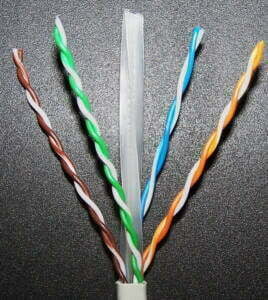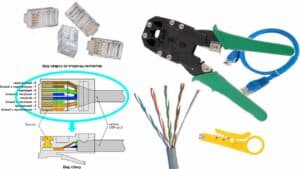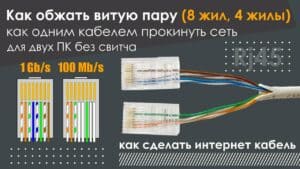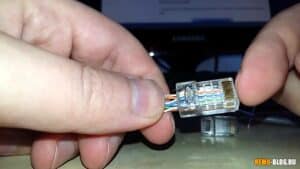Understanding the different types of internet cables
Internet cables come in different types, and each of them has its own features and advantages. For example, coaxial cable provides high data transfer speeds, but its length is limited. At the same time, twisted pair cable is a more flexible solution that allows you to transfer data over long distances without losing speed. To select a suitable cable for the Internet, several factors must be taken into account. First of all, this is the speed that is required to work on the network. If you need to transfer large amounts of data, then you should pay attention to coaxial cable. If you need to provide high Internet speed over long distances, then it is better to choose twisted pair. An important factor when choosing a cable for the Internet is also its quality. You should not save on buying a cable, as a low-quality cable can lead to loss of data transfer speed and other problems in the network. In general, the choice of a suitable cable for the Internet depends on the specific needs and operating conditions of the network. It is important to consider the data transfer speed, the distance over which the data needs to be transferred, and the quality of the cable.
What cable is needed to connect to a Wi-Fi router?
To connect to a Wi-Fi router, you need to use a network cable, also known as an Ethernet cable or LAN cable. This cable is used to transfer data between devices on a local network.
Cables can be of different types and categories. A cable's category indicates its maximum data transfer rate. The most common categories of network cables are Cat5, Cat5e and Cat6.
Cat5 is a standard cable that supports data transfer rates up to 100 Mbps. Cat5e is an improved version of Cat5 cable that supports speeds up to 1 Gbps. Cat6 is the newest and fastest cable that supports speeds up to 10 Gbps.
When choosing a cable to connect to a Wi-Fi router, you need to consider the speed of your Internet connection and the data transfer speed requirements on your local network. If you have a fast Internet connection and often transfer large files between devices on your local network, then it is better to use a higher category cable, such as Cat6.
In addition to the cable category, you also need to pay attention to the cable length. The cable length should not exceed 100 meters, otherwise it may lead to signal loss and deterioration in the quality of data transmission.
Choosing the right cable to connect to your Wi-Fi router can affect the Internet speed and data transfer on your local network. Therefore, it is recommended to choose a cable based on the requirements of your network and use a high-quality cable from trusted manufacturers.
The cable for connecting to the computer’s network card is an important element that determines the speed and stability of the Internet connection. The main types of cables are twisted pair and optical fiber. Twisted pair cable is the most common type of cable and is suitable for home and office networks. Fiber is a more expensive option and is used in large networks and data centers. When choosing a cable, you need to take into account the length of the line, Internet speed and the type of network card on your computer. It is important to choose a high quality cable and install it correctly to ensure a stable and fast Internet connection.
Internet cable: what is it called and how to choose the right one
Choosing an internet cable may seem like a daunting task, but it's actually quite simple. For home and office networks, three types of cables are most often used: twisted pair, coaxial and fiber optic.
Twisted pair is the most common type of cable. This cable has a high data transfer rate and is suitable for most tasks. Coaxial cable is used less often, but it is more reliable and has higher protection against interference. Fiber optic cable is the most expensive and difficult to use, but it has the highest data transfer rate and reliability.
When choosing a cable, you need to consider not only its type, but also its category. The cable category determines its capacity and data transmission range. For a home network, Category 5e or 6 is usually sufficient, but for an office network, Category 7 or higher cable may be required.
It is also important to consider the length of the cable. For twisted pair, it is recommended to have no more than 100 meters, for coaxial - no more than 500 meters, and for fiber optic - unlimited.
As a result, the correct choice of cable for the Internet depends on the specific requirements and conditions of use. However, taking into account the features described above, you can choose the appropriate cable and ensure stable and fast Internet operation in your home or office.
Difference Between Ethernet Cable Categories
Ethernet cables are used to connect computers to a local network or the Internet. There are several categories of cables: Cat5, Cat5e, Cat6, Cat6a and Cat7.
Cat5 is a standard cable that supports speeds up to 100 Mbps. It is used to connect home computers and small office networks.
Cat5e is an improved version of Cat5. It supports speeds up to 1 Gbps and is used for more complex networks such as enterprise networks.
Cat6 is a cable that supports speeds up to 10 Gbps over distances of up to 55 meters. It is used for larger networks such as data centers.
Cat6a is an improved version of Cat6. It supports speeds up to 10 Gbps at distances up to 100 meters and is used for networks with a large number of devices.
Cat7 is the newest cable standard that supports speeds up to 10 Gbps at distances up to 100 meters. It also has interference protection and is used for networks with high data security requirements.
The cable you choose depends on your network specifications. If you are using a home network, then Cat5e will be sufficient. If you have a large network, then choose Cat6 or Cat6a. If you work with sensitive data, choose Cat7 for maximum security.
A gigabit network cable is more than just a wire that connects your computer to the internet. It is a key element that ensures fast and stable network access. Choosing the right gigabit network cable is a key element that determines the speed and reliability of your connection.
First of all, you need to decide on the type of cable for the gigabit network. There are several options: twisted pair (Cat5, Cat5e, Cat6, Cat6a), fiber optic (Singlemode, Multimode), coaxial cable.
For home networks, the most suitable option is Cat6 or Cat6a twisted pair. These cables provide data transfer rates of up to 10 Gbit/s, which allows you to transfer a large amount of information without delays or losses.
In addition, when choosing a cable, you need to pay attention to its length and quality. You should not skimp on cable, as this can negatively affect the speed and quality of your Internet connection.
Thus, choosing a cable for a gigabit network is an important step in creating a fast and reliable home network. Decide on the type of cable, pay attention to its length and quality, and you will be able to enjoy fast and stable Internet.
Optimal cable length for the Internet
When choosing an Internet cable, it is important to consider not only its name and type, but also its length. The optimal cable length depends on several factors, such as the type of connection, internet speed and distance between devices.
For connection with an Ethernet cable, the optimal length is up to 100 meters. If the length exceeds this limit, the Internet speed may be reduced or the connection may be lost.
For connection with a coaxial type cable (RG6 or RG59), the optimal length is up to 500 meters. However, for higher Internet speeds, it is recommended to use a shorter cable length.
Finally, for connecting with an optical cable, the length is not limited and can reach several kilometers. However, it is worth considering that optical cable is more expensive and difficult to install.
When choosing an internet cable, you need to consider not only the optimal length, but also the quality of the cable, its type and compatibility with devices. Only then can you ensure a stable and fast connection. When choosing an internet cable, we often wonder if the length of the cable affects the internet speed. Internet cables come in different types and lengths, but the most common type is twisted pair. Cable length does affect internet speed, but not to the extent that many people think. The cable should be long enough to reach from the router to the device, but not too long so as not to reduce internet speed. The optimal length of an internet cable is up to 100 meters. An excessively long cable can lead to poor connection quality and a decrease in data transfer speed. Therefore, when choosing an internet cable, you need to consider not only the length, but also other characteristics, such as the type and category of cable. How to minimize signal loss with long cables
When using long cables to transmit an internet signal, signal loss and a decrease in data transfer speed are possible. To minimize these losses, you can use cables with a higher data transfer speed, as well as install signal amplifiers at intermediate sections of the cable. It is also important to choose the right cable type depending on the specific conditions of use. For example, twisted pair is recommended for use over long distances, and coaxial cable is recommended for use inside buildings. In addition, it is necessary to consider the quality of the cable and its shielding to avoid external noise and interference.
Read further:






